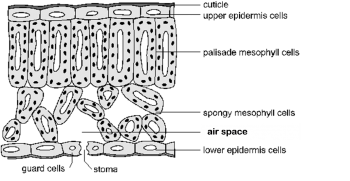Serendip is an independent site partnering with faculty at multiple colleges and universities around the world. Happy exploring!
Photosynthesis Investigation
 In the first part of this activity, students learn how to use the floating leaf disk method to measure the rate of net photosynthesis (i.e. the rate of photosynthesis minus the rate of cellular respiration). They use this method to show that net photosynthesis occurs in leaf disks in a solution of sodium bicarbonate, but not in water. Questions guide students in reviewing the relevant biology and analyzing and interpreting their results. In the second part of this activity, student groups develop hypotheses about factors that influence the rate of net photosynthesis, and then each student group designs and carries out an investigation to test the effects of one of these factors. (NGSS)
In the first part of this activity, students learn how to use the floating leaf disk method to measure the rate of net photosynthesis (i.e. the rate of photosynthesis minus the rate of cellular respiration). They use this method to show that net photosynthesis occurs in leaf disks in a solution of sodium bicarbonate, but not in water. Questions guide students in reviewing the relevant biology and analyzing and interpreting their results. In the second part of this activity, student groups develop hypotheses about factors that influence the rate of net photosynthesis, and then each student group designs and carries out an investigation to test the effects of one of these factors. (NGSS)
Download Student Handout: PDF format or Word format
Download Teacher Preparation Notes: PDF format or Word format
We invite comments on this Hands-On Activity and the accompanying Teacher Preparation Notes, including suggestions for other teachers who are planning to use the activity, useful preparatory or follow-up activities, additional resources or any questions you have related to the activity, or a brief description of any problem you might have encountered. If you would prefer to send your comments or questions in a private message, please write Ingrid Waldron at iwaldron@sas.upenn.edu.











Comments
key
Hello, Could I get an answer key as well. Thank you!
Key is now available.
You can obtain a key and a slightly revised version of the Student Handout by writing to iwaldron@upenn.edu.
Ingrid Waldron
Making up the sodium bicarbinate solution
Could you tell me how many grams of baking soda I would need to add to 300ml of water to make a .3-.5% solution?
Thank you for the help!
Sasha
Sodium bicarbonate solution
For a 0.3% solution of sodium bicarbonate, you would add 0.9 grams of sodium bicarbonate to 300 mL of water. For a 0.5% solution of sodium bicarbonate, you would add 1.5 grams of sodium bicarbonate to 300 mL of water. For a 0.2% solution of sodium bicarbonate, you would add 0.6 grams of sodium bicarbonate to 300 mL of water. (See http://www.physiologyweb.com/calculators/percent_solutions_calculator.html.)
2016 revision
The revisions have improved the clarity and accuracy of the Student Handout and Teacher Preparation Notes. Also, a key is now available upon request.
Answer Key
Hi Ingrid,
Do you have an answer key to the student handout for this activity? If you do, could you send it to davey@goasa.org? Thanks so much!
Annabelle
Resources for knowing the answers
Hi Annabelle,
We do not have an answer key for the “Photosynthesis Investigation” activity. However, I believe that the information in the Student Handout and Teacher Preparation Notes (supplemented by a good standard introductory text) should make it relatively easy to prepare a key. If you have any additional questions beyond the information in the Student Handout and Teacher Notes, please let me know and I will be happy to answer your questions.
Ingrid
PS If we have an answer key for an activity, it is always mentioned near the beginning of the Instructional Suggestions and Background Information section of the Teacher Preparation Notes.
Post new comment